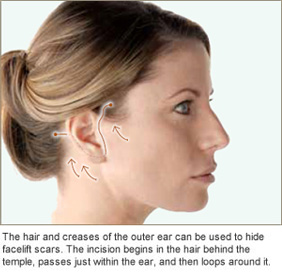Understanding the Surgery

Your surgeon begins the incision in the area of the temple hair, just above and in front of the ear. Next it continues under the earlobe and follows the back of the ear and blends into the hairline. The skin is gently lifted as the surgeon repositions and tightens the underlying muscle and connective tissue. Some fat may be removed, as well as excess skin. For men, the incision is aligned to accommodate the natural beard lines. In all cases, the incisions are placed where they will fall in a natural crease of the skin for camouflage.
In all cases, the incisions are placed where they will fall in a natural crease of the skin for camouflage. After trimming the excess skin, the surgeon closes the incisions with fine sutures and/or metal clips. This will permit precise surgery and avoid shaving hair in the incision sites. Depending on the extent of the surgery, the process can take from two to four hours.
When the procedure is performed with a combination of mild sedatives, local anesthesia, and a mild intravenous anesthesia ("twilight sleep"), the patient will experience little discomfort. Some surgeons will prefer general anesthesia for their facelifts. Following the surgery, the surgeon will apply a dressing to protect the entire area where the incisions have been made. Actual placement of incisions varies from patient to patient and is dependent on the surgeon's judgment for that patient.
What To Expect After the Surgery
Even though most patients experience minimal pain after surgery, the surgeon will still prescribe medication. Some degree of swelling and bruising is unavoidable, and your surgeon may instruct you to use cold compresses to keep swelling to a minimum. If a dressing has been applied, it will be removed within one to two days. The surgeon will also instruct you to keep your head elevated when lying down, to avoid as much activity as possible, and to report any undue discomfort. Although there are few complications in facelift surgery (thousands are performed each year), some risk exists in any surgery. In some cases, a drainage tube may have been inserted during surgery. This will typically be removed on the first or second day after surgery. All sutures and staples are usually removed within five to 10 days following surgery.
Surgeons generally recommend that patients avoid vigorous activity. Patients should prearrange for post-surgery support from family and friends. Recovery usually takes two to three weeks, though many patients go back to work in two weeks. Scars are usually not noticeable after enough time has passed for them to mature. In any case, they are easily disguised in natural skin creases, by the hair, or, in persistent cases, by makeup until total healing has occurred. Since surgery does not stop the aging process some relaxation of tissues can occur over the first few weeks. The goal of an artistic facelift is natural beauty without the tell-tale signs of being “overdone”.